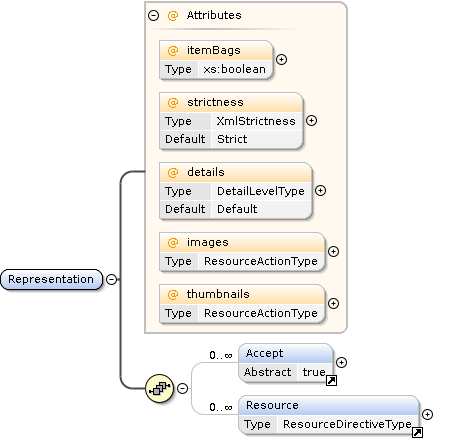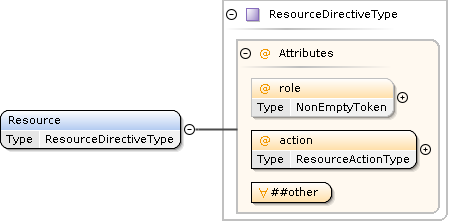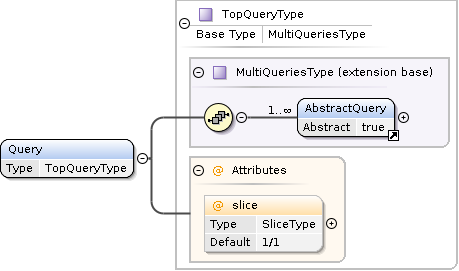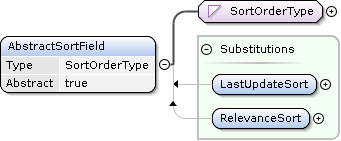Actions
Search Actions
Concrete Search Requests
SearchRequest Template
Search Actions are derived from the AbstractSearchRequest type, which acts as a template for all search based actions.

AbstractSearchRequest Type
Representation Element
The Representation element is used to specify how the result items should be delivered.

Representation Element
The details attribute can be used to select presets of result representation scope and fidelity.
The Resource child element can be used to override defaults and further refine the result data.
Each action has a set of supported resource roles, some common, like item (representing the whole search result item), image (the associated images), and document (the associated documents).
Some are specific to the concrete action and are called item facets. They represent additional associated data related to the search result item.
For example, if you want each item as a separate file within the ZIP Bundle, use the following:
<Representation xmlns="urn:ige:schema:xsd:datadeliverycommon-1.0.0">
<Resource role="item" action="Bundle"/>
</Representation>
The special roles * and facet/* can be used to assign a ResourceAction to all roles or all item facet roles, respectively.
<Representation xmlns="urn:ige:schema:xsd:datadeliverycommon-1.0.0">
<Resource role="*" action="Bundle"/>
</Representation>
ResourceAction |
Description |
|---|---|
|
Reference with a URI |
|
Embed into the result XML |
|
Add to the result ZIP Bundle |
|
Inline as RFC2397 data URL |
|
Do not include in the result |

Resource Element
Page Element
The Page element is used to control the paging of the result items.

Page Element
Query Element
The Query element is used to describe the search criteria.
Concrete request types can extend the AbstractDefinedFieldsQuery element to provide domain specific search criteria.
see also: How-To: Building Search Queries

Query Element

AbstractDefinedFieldsQuery
Sort Element
The Sort element is used to describe the sorting criteria.
Concrete request types can extend the AbstractSortField element to provide domain specific sorting criteria.

Sort Element

AbstractSortField
Special Actions
UserQuota Action
Specification |
Value |
|---|---|
XSD Documentation |
|
XSD Schema |
|
Action element content |
|
Action |
|
<?xml version="1.0" encoding="UTF-8"?>
<ApiRequest xmlns:xsi="http://www.w3.org/2001/XMLSchema-instance"
xsi:schemaLocation="
urn:ige:schema:xsd:datadeliverycore-1.0.0 urn:publicid:-:IGE:XSD+DATADELIVERYCORE+1.0.0:EN
urn:ige:schema:xsd:datadeliveryquota-1.0.0 urn:publicid:-:IGE:XSD+DATADELIVERYQUOTA+1.0.0:EN"
xmlns="urn:ige:schema:xsd:datadeliverycore-1.0.0">
<Action type="UserQuota">
<UserQuotaRequest xmlns="urn:ige:schema:xsd:datadeliveryquota-1.0.0"/>
</Action>
</ApiRequest>
Echo Action
Specification |
Value |
|---|---|
Action element content |
any non |
Action |
|
<?xml version="1.0" encoding="UTF-8"?>
<ApiRequest xmlns:xsi="http://www.w3.org/2001/XMLSchema-instance" xsi:schemaLocation="
urn:ige:schema:xsd:datadeliverycore-1.0.0 urn:publicid:-:IGE:XSD+DATADELIVERYCORE+1.0.0:EN
http://www.w3.org/1999/xhtml http://www.w3.org/2002/08/xhtml/xhtml1-strict.xsd"
xmlns="urn:ige:schema:xsd:datadeliverycore-1.0.0">
<Action type="Echo">
<div xmlns="http://www.w3.org/1999/xhtml">
<span>Hello IPI & friends! <3</span>
<span>äëü éèê</span>
</div>
</Action>
<Action type="Echo">
<script xmlns="http://www.w3.org/1999/xhtml" type="dbg">AGAIN=foo! AGAIN=bar! AGAIN=baz!</script>
</Action>
<Action type="Echo">
<script xmlns="http://www.w3.org/1999/xhtml" type="dbg">THROW=testing boom!</script>
</Action>
</ApiRequest>
No Action
<?xml version="1.0" encoding="UTF-8"?>
<ApiRequest xmlns="urn:ige:schema:xsd:datadeliverycore-1.0.0"/>